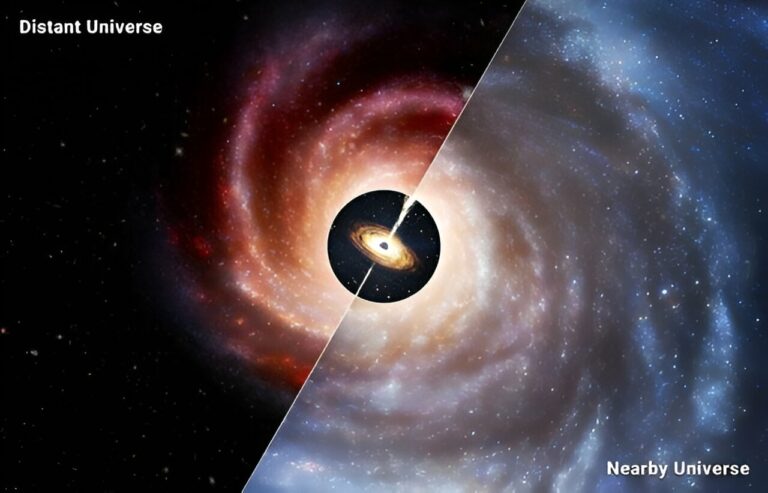Surprisingly Enormous Black Holes Take Center Stage in Small Galaxies Across the Distant Universe
Astronomers have made a remarkable discovery regarding the supermassive black holes situated at the centers of early galaxies. These black holes are significantly more massive than what was initially anticipated. This unexpected finding provides valuable insights into the origins of all supermassive black holes, as well as the initial stages of their host galaxies’ existence.
In fully developed galaxies like our own Milky Way, the collective mass of stars greatly surpasses the mass of the central black hole by a ratio of approximately 1,000 to 1. However, in these newly discovered distant galaxies, this mass difference decreases to 100 or even 10 to 1. In some cases, the black hole’s mass can even match the combined mass of all the stars in its host galaxy.
This revelation of unusually massive black holes in young galaxies is a result of the observations made by the James Webb Space Telescope (JWST), NASA’s most recent flagship observatory. Prior to the launch of JWST in late 2021, astronomers were primarily limited to studying distant black holes through the observation of immensely bright quasars. These quasars consist of colossal black holes that consume matter and emit intense light, overshadowing the stars within their host galaxies.
“With the advent of JWST, we can now observe lower-mass supermassive black holes in small, distant galaxies, while also being able to observe the stars within these host galaxies,” explains Fabio Pacucci, a Clay Fellow at the Center for Astrophysics | Harvard & Smithsonian (CfA). “This groundbreaking capability allows us to study the early stages of black holes and their coevolution with their host galaxies for the very first time.”
Pacucci is the primary author of a recent study published in The Astrophysical Journal Letters, which presents the findings. These results were also presented at the 243rd meeting of the American Astronomical Society in New Orleans, LA.
According to Roberto Maiolino, a professor at the University of Cambridge (UK) and co-author of the study, “We have discovered that distant, young galaxies deviate from the well-established relationship between black hole mass and stellar mass that is observed in nearby, mature galaxies. These early black holes are significantly more massive compared to the stellar population of their host galaxies.” He further adds, “With the help of JWST, we will be able to identify the formation process of the first supermassive black holes by locating black holes that are smaller and farther away than the ones discovered so far. Our study predicts that these black holes will be quite abundant.”
To conduct the study, Pacucci and colleagues performed a statistical analysis of 21 galaxies, ranging from approximately 12 to 13 billion light-years away. These galaxies were observed through three JWST surveys that have been previously published.
These 21 galaxies contain central black holes with estimated masses that are tens or hundreds of millions of times greater than that of our sun. While still considered supermassive, these black holes are relatively small compared to the ones powering most of the distant quasars observed to date, which have billions of times the mass of the sun.
Xiaohui Fan, a professor at the University of Arizona and co-author of the study, states, “Overall, we have observed that the black holes in the young galaxies studied by JWST are approximately ten to a hundred times more massive than what the scaling relation in the local universe predicts.” He adds, “The ratio of stellar mass to black hole mass in early galaxies was much lower over twelve billion years ago compared to the present time. This finding has significant implications for studying the initial population of black holes.”
Accurately determining this ratio will provide valuable insights into the origins of supermassive black hole precursors, also known as black hole seeds. Astronomers have broadly outlined two main pathways for their formation: “light” or “heavy” seeds.
This article is republished from PhysORG under a Creative Commons license. Read the original article.
Do not forget to share your opinion with us to provide you with the best posts !




0 Comments